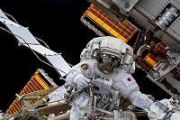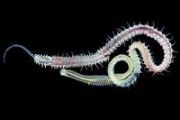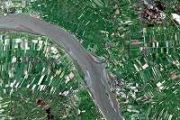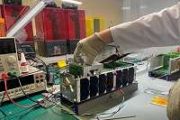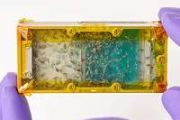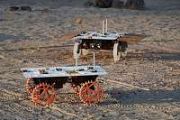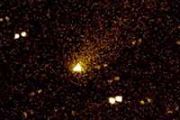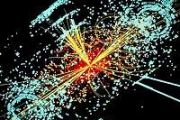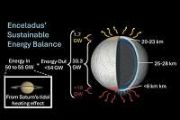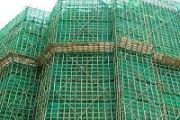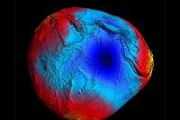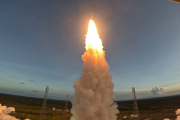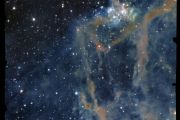
Copernical Team
Exoplanet has Earth-like layered atmosphere made of titanium gas
 Scientists have discovered that a planet outside of the solar system may have a complex atmosphere made of metal gases that operate like Earth's atmosphere.
The research, published in the journal Nature Astronomy, found evidence that metals discovered in the atmosphere of WASP-189b are layered - the first time research has suggested that gas giant planets like Jupiter might have a comp
Scientists have discovered that a planet outside of the solar system may have a complex atmosphere made of metal gases that operate like Earth's atmosphere.
The research, published in the journal Nature Astronomy, found evidence that metals discovered in the atmosphere of WASP-189b are layered - the first time research has suggested that gas giant planets like Jupiter might have a comp Space Foundation Launches Space Commerce Institute
 Space Foundation, a nonprofit advocate organization founded in 1983 for the global space ecosystem, has launched Space Commerce Institute, a program offered by Center for Innovation and Education to facilitate access and growth for university students, entrepreneurs, businesses and professionals.
"We have entered the era of access and opportunity with a broad range of new innovators in the
Space Foundation, a nonprofit advocate organization founded in 1983 for the global space ecosystem, has launched Space Commerce Institute, a program offered by Center for Innovation and Education to facilitate access and growth for university students, entrepreneurs, businesses and professionals.
"We have entered the era of access and opportunity with a broad range of new innovators in the Boost for space clusters across the UK
 These regional hubs, known as space clusters, will support new and growing companies, building on local expertise and catalysing investment into the space sector.
Over 600,000 pounds will go towards supporting activities that create jobs and growth, including recruiting space cluster managers, to strengthen local space sector leadership groups and developing new business opportunities.
These regional hubs, known as space clusters, will support new and growing companies, building on local expertise and catalysing investment into the space sector.
Over 600,000 pounds will go towards supporting activities that create jobs and growth, including recruiting space cluster managers, to strengthen local space sector leadership groups and developing new business opportunities. ASTRA rebrands as Orion Space Solutions
 Atmospheric and Space Technology Research Associates, LLC, or "ASTRA" announces completion of a major rebranding and is now doing business as Orion Space Solutions (OSS).
"Our new identity - Orion Space Solutions, LLC - continues to emphasize our space domain expertise and history of imagining, implementing, and actualizing all aspects of our customers' space mission requirements," says Ge
Atmospheric and Space Technology Research Associates, LLC, or "ASTRA" announces completion of a major rebranding and is now doing business as Orion Space Solutions (OSS).
"Our new identity - Orion Space Solutions, LLC - continues to emphasize our space domain expertise and history of imagining, implementing, and actualizing all aspects of our customers' space mission requirements," says Ge Turion Space and NanoAvionics to build a satellite for orbital reconnaissance mission
 US company Turion Space, aiming to build spacecraft to remove orbital-debris, satellite servicing, and domain awareness, has selected NanoAvionics small satellite bus, the MP42, as the basis for its 'Droid-1' spacecraft designed for a reconnaissance mission in low Earth orbit (LEO). The launch of the Droid-1 satellite is planned for the first quarter of 2023.
Using its onboard sensors, Tur
US company Turion Space, aiming to build spacecraft to remove orbital-debris, satellite servicing, and domain awareness, has selected NanoAvionics small satellite bus, the MP42, as the basis for its 'Droid-1' spacecraft designed for a reconnaissance mission in low Earth orbit (LEO). The launch of the Droid-1 satellite is planned for the first quarter of 2023.
Using its onboard sensors, Tur From Earth to Mars and Beyond
 Raytheon Intelligence and Space provides end-to-end space solutions that span the space value stream. From Earth observation and more accurate weather predictions to satellite constellation management and searching for signs of life on Mars, RI&S incorporates transformative, next-generation technologies to help deliver mission breakthroughs for its customers.
They make it possible to warn
Raytheon Intelligence and Space provides end-to-end space solutions that span the space value stream. From Earth observation and more accurate weather predictions to satellite constellation management and searching for signs of life on Mars, RI&S incorporates transformative, next-generation technologies to help deliver mission breakthroughs for its customers.
They make it possible to warn Solar flare expected to start hitting earth Wednesday
 A solar flare, ejected from our sun towards the end of January, will start hitting earth Wednesday, according to the National Oceanic and Atmospheric Administration's Space Weather Prediction Center.
The flare is the result of a coronal mass ejection, a large expulsion of plasma and magnetic field from the Sun's corona, which can travel from the Sun to Earth at speeds as fast as 1,800 m
A solar flare, ejected from our sun towards the end of January, will start hitting earth Wednesday, according to the National Oceanic and Atmospheric Administration's Space Weather Prediction Center.
The flare is the result of a coronal mass ejection, a large expulsion of plasma and magnetic field from the Sun's corona, which can travel from the Sun to Earth at speeds as fast as 1,800 m Moons may yield clues to what makes planets habitable
 Earth's moon is vitally important in making Earth the planet we know today: the moon controls the length of the day and ocean tides, which affect the biological cycles of lifeforms on our planet. The moon also contributes to Earth's climate by stabilizing Earth's spin axis, offering an ideal environment for life to develop and evolve.
Because the moon is so important to life on Earth, scie
Earth's moon is vitally important in making Earth the planet we know today: the moon controls the length of the day and ocean tides, which affect the biological cycles of lifeforms on our planet. The moon also contributes to Earth's climate by stabilizing Earth's spin axis, offering an ideal environment for life to develop and evolve.
Because the moon is so important to life on Earth, scie Sols 3376-3377: Second Servings at the Prow
 The above image is a MAHLI image of a small part of the Toron block in front of the rover. Take a moment to marvel at all the details. We arrived here two sols ago and didn't drive away just yet to get some second servings. If you look closely at the image above, all the details will be telling you why we are very happy that we are able to get second servings of the Toron block.
In other w
The above image is a MAHLI image of a small part of the Toron block in front of the rover. Take a moment to marvel at all the details. We arrived here two sols ago and didn't drive away just yet to get some second servings. If you look closely at the image above, all the details will be telling you why we are very happy that we are able to get second servings of the Toron block.
In other w NASA-Funded Study Extends Period When Mars Could Have Supported Life
 The surface of Mars is barren and inhospitable, but perhaps it wasn't always that way. Billions of years ago, when life emerged on Earth, the climate of Mars could have been Earth-like as well, with a thicker atmosphere than today and oceans of liquid water. A study funded by NASA and international partners indicates this period could have lasted longer than originally thought.
"Our simula
The surface of Mars is barren and inhospitable, but perhaps it wasn't always that way. Billions of years ago, when life emerged on Earth, the climate of Mars could have been Earth-like as well, with a thicker atmosphere than today and oceans of liquid water. A study funded by NASA and international partners indicates this period could have lasted longer than originally thought.
"Our simula 



